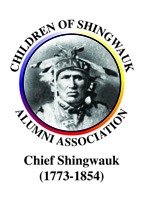Children of Shingwauk Alumni Association facts for kids
 |
|
| Abbreviation | CSAA |
|---|---|
| Formation | 1998 |
| Founder | Michael Cachagee, Shirley Fletcher Horn, Don Jackson |
| Founded at | Sault Ste Marie, Ontario |
|
Region
|
Canada |
|
CSAA Chair
|
George Diamond |
|
Vice Chair
|
Margaret Diamond |
The Children of Shingwauk Alumni Association (CSAA) is a group started by people in the community. It helps survivors and their families who went to residential schools in Canada. The organization is based in Sault Ste. Marie, Ontario.
Contents
How the CSAA Started
Before 1998, the Children of Shingwauk Alumni Association was an informal group. They mostly focused on organizing special get-togethers for former students of the Shingwauk Indian Residential School. These events invited former students, staff, and community members. They came back to the old school site to share their experiences and connect with others.
The CSAA held its first official meeting in 1998. That same year, they opened an office at Algoma University College. Also in 1998, the Shingwauk Project and the CSAA started the Shingwauk Healing Project. This project was created to help people share, heal, and learn about the lasting effects of residential schools.
In 2020, the historical records of the Children of Shingwauk Alumni Association were recognized by UNESCO. They were added to Canada's Memory of the World Register. This means these records are very important to Canadian history.
Shingwauk Reunions: Connecting the Past
The very first Shingwauk reunion happened in 1981. It took place at Algoma University College, which is on the same land where the Shingwauk Indian Residential School used to be.
Ten years later, in 1991, the second reunion was held at the same location. This event was called "Shingwauk Reunion 1991: 160th anniversary of Chief Shingwauk's Vision." Hundreds of residential school survivors, community members, and others attended. At this reunion, many former students began to speak openly about their experiences at the Shingwauk School.
The third gathering of former students and staff took place from July 4 to 7, 1996. During this reunion, the Children of Shingwauk Alumni Association made an important statement. It was called the "Declaration of the Shingwauk Reunion 1996." In this declaration, the former students promised to continue the vision of Chief Shingwauk. They also committed to ongoing work for healing and education. This declaration and the activities that followed led to the official creation of the Children of Shingwauk Alumni Association.
Working with Algoma University
The CSAA has a long-standing partnership with Algoma University. They also work with other groups located on the historic Shingwauk site. The CSAA has two spots on the board of the Shingwauk Education Trust. They are also part of several committees at Algoma University, like the Anishinaabe Peoples' Council. The CSAA also has a seat on the Algoma University board of governors.
In 2006, Algoma University and the Children of Shingwauk Alumni Association signed an official agreement. This document guides their partnership. It also explains how the CSAA's historical collection, kept at the Shingwauk Residential Schools Centre, is managed. Since 2006, the CSAA has continued to be involved in university decisions. These decisions often relate to Indigenous communities, reconciliation, and residential schools.
In 2017, Algoma University made a statement about the Truth and Reconciliation Commission of Canada. This statement was greatly influenced by the CSAA's experiences. It showed the university's commitment to remembering the history of the Shingwauk Residential School survivors.
Important Programs and Projects
In 2003, the CSAA became a founding partner of the National Residential School Survivor Society. This national group spoke up for survivors during the Indian Residential Schools Settlement Agreement process. The next year, in 2004, Indian Residential Schools Resolutions Canada chose the CSAA. They became the Ontario site for a special project to help resolve disputes.
From 2008 to 2014, the CSAA managed a program for Health Canada in Ontario. This program provided health and cultural support workers. These workers helped at community events and national Truth and Reconciliation Commission of Canada events. They also offered support during a process where survivors could share their stories. In 2014, the Children of Shingwauk Alumni Association stopped this program. Ontario Indian Residential Schools Support Services then took over the work.
In 2012, the CSAA and Shingwauk Kinoomaage Gamig started the Charlie Hunter Scholarship fund. This scholarship helps students who are descendants of residential school survivors. It is for those studying at Algoma University. The scholarship honors Charlie Hunter, a student who passed away at St. Anne's Indian Residential School. Charlie was buried at the school against his family's wishes. His family worked for over thirty years to bring his body back home. In 2011, Charlie's body was finally returned to his home community of Peawanuck, Ontario.
In 2016, the Children of Shingwauk Alumni Association worked with the Archives of Ontario. This was done through the Shingwauk Residential Schools Centre. They helped create the "Family Ties: Ontario Turns 150" exhibit. This exhibit included information about the Shingwauk family and the Shingwauk Residential School.
CSAA Logo and Art
The CSAA logo uses a picture of Chief Shingwauk from the 1850 Robinson-Huron Treaty signing. This image is available for public use. Chief Shingwauk signed the 1850 Robinson Huron Treaty, and the Shingwauk Indian Residential School was named after him.
Since 1981, the CSAA has asked local Indigenous artists to create artwork. This art is used for promotion and educational programs. This artwork is now part of the Shingwauk Residential Schools Centre's collection. It is also displayed at Algoma University. Some of the commissioned artworks include:
- Shingwaukonse: Rising Crane (1981), by Brian Wagoosh
- Shingwauk's Vision: The Teaching Wigwam (1991), by Jesse Agawa
- Gathering (2002), by Leland Bell
- Celebrating Resilience Through Education (2012), by Shelly Fletcher
See also

